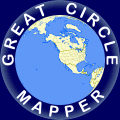FAQ: Airport Database
- Q: Where did the airport data come from?
- A: The location database (it includes heliports, seaplane bases, spaceports, railway stations, and other locations besides airports) is derived from a variety of sources. Sources are listed on the credits page. Custom software (over 25,000 lines of Perl) and a great deal of manual editing is used to audit and combine data from these sources into a single, comprehensive database.
- Q: Why isn't data from IATA used?
- A: IATA charges a prohibiively large and recurring price for their data. In addition, the reliability of IATA data is uncertain. In one example IATA had a very precise location for an airport (down to a fraction of an arc second) which was over 30 kilometers away from the correct location for the airport.
- Q: What is DAFIF and what happened to it?
- A: DAFIF® is a compendium of aeronautical data produced by the National Geospatial-Intelligence Agency. NGA ceased distributing DAFIF to the public (it is still maintained for US military use) effective 1 October 2006. DAFIF data that was effective at the time is still used in the Great Circle Mapper's database but is being steadily replaced with data from other sources.
- Q: How much authoritative airport data is used?
- A:
Authoritative data from over 110 countries is included in the
Great Circle Mapper's location database, accounting for about 62.4%
of the database.
Generally authoritative data is found in a document known as the Aeronautical Information Publication (AIP) but occasionally is published in other forms. Notably, the FAA uses an entirely different format for the United States, a database dump rather than the print-oriented AIP format.
For a few countries, country-wide data is unavailable but authoritative data published by individual airports is used.
- Q: Why isn't authoritative data from AIP Australia used?
- A: The Australian government charges an exorbitant price for most official aviation data and places stringent restrictions on its republication. It would not be possible to offer the Great Circle Mapper as a free resource if it included this data.
- Q: Why isn't authoritative data from AIP China used?
- A: The Chinese government sells AIP data for a substantial annual fee. Data for most Chinese airports has been compiled from free sources.
- Q: Why isn't official data from other countries used?
- A:
Official data from over 110 countries is included in the database.
Some countries sell their AIP data or have relationships with commercial entities which sell this data or place copyright restrictions on the use of their data. Data for these countries has been compiled from free sources in order to allow the Great Circle Mapper to be available as a free resouce.
Other countries have freely available AIP data which have yet to be incorporated into the Great Circle Mapper's database. This data is being incorporated as time and resources permit.
- Q: What does AIP mean?
- A:
AIP is an initialism for Aeronautical Information Publication. Defined by the
International Civil Aviation Organization (ICAO),
a country or its delegate publishes lasting aeronautical information
via an AIP. (Contrast this to transient information published via NOTAMs,
aviation circulars, and similar notices.)
AIPs are effective on a fixed, 28-day cycle known as an Aeronautial Information Regulation And Control (AIRAC) cycle. The United States used a 56-day cycle until early 2017, skipping every other date, but now uses the 28-day cycle. Updates are distributed well in advance of the cycle's effective date to allow time for systems to be updated with the new data before it takes effect.
For more information, see the Aeronautical Information Publication article at Wikipedia.
- Q: I found a problem in the data. Will you fix it?
- A: Of course! The Great Circle Mapper strives to have the best airport data that can be assembled. Please report database errors via e-mail to karl@kls2.com. Once verified, they will be fixed as soon as possible.
- Q: Can I have a copy of the database?
- A: Subsets of the Great Circle Mapper's airport database may be available for sale in the future. Please check back for availability.
- Q: How many locations are in the database?
- A: At the time this was last updates (December 2023), the Great Circle Mapper's database included approximately 70,600 codes representing 42,725 locations.
|
Information on this site may not be accurate or current and is not valid for flight planning or navigation. No warranty of fitness for any purpose is made or implied. Flight planning and navigation should only be done using official charts.
Copyright © 1996-2024
Karl L. Swartz.
All rights reserved.
|
